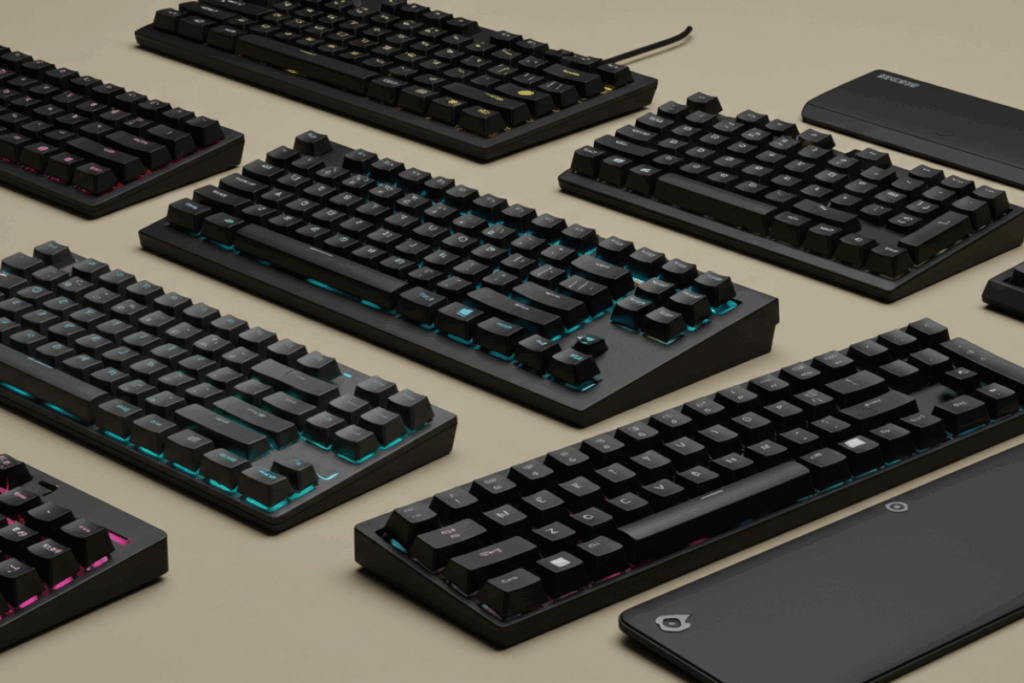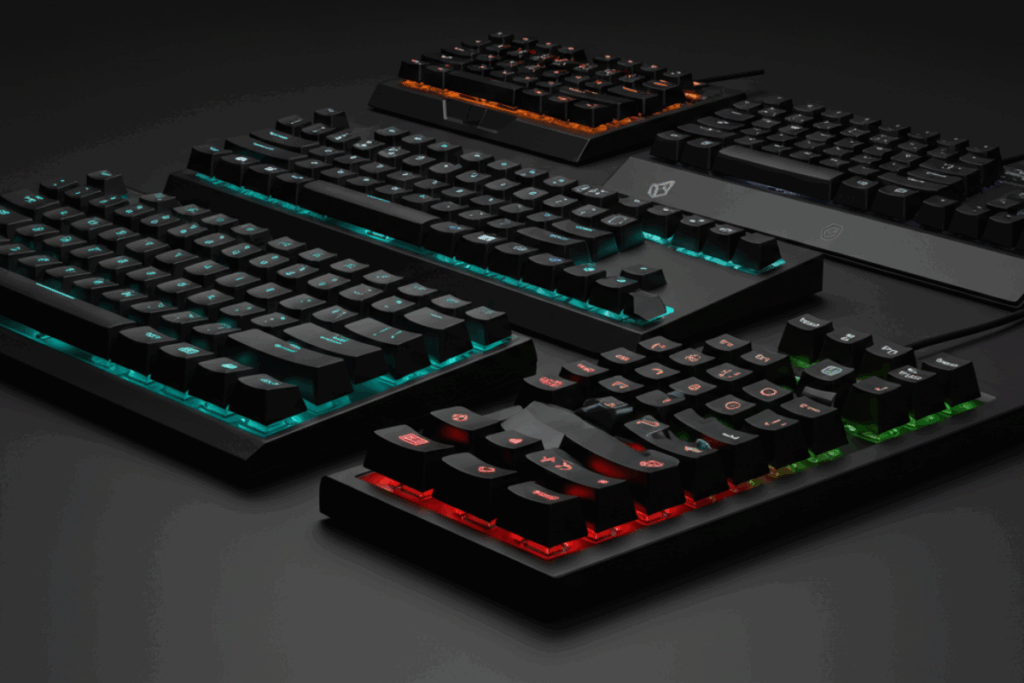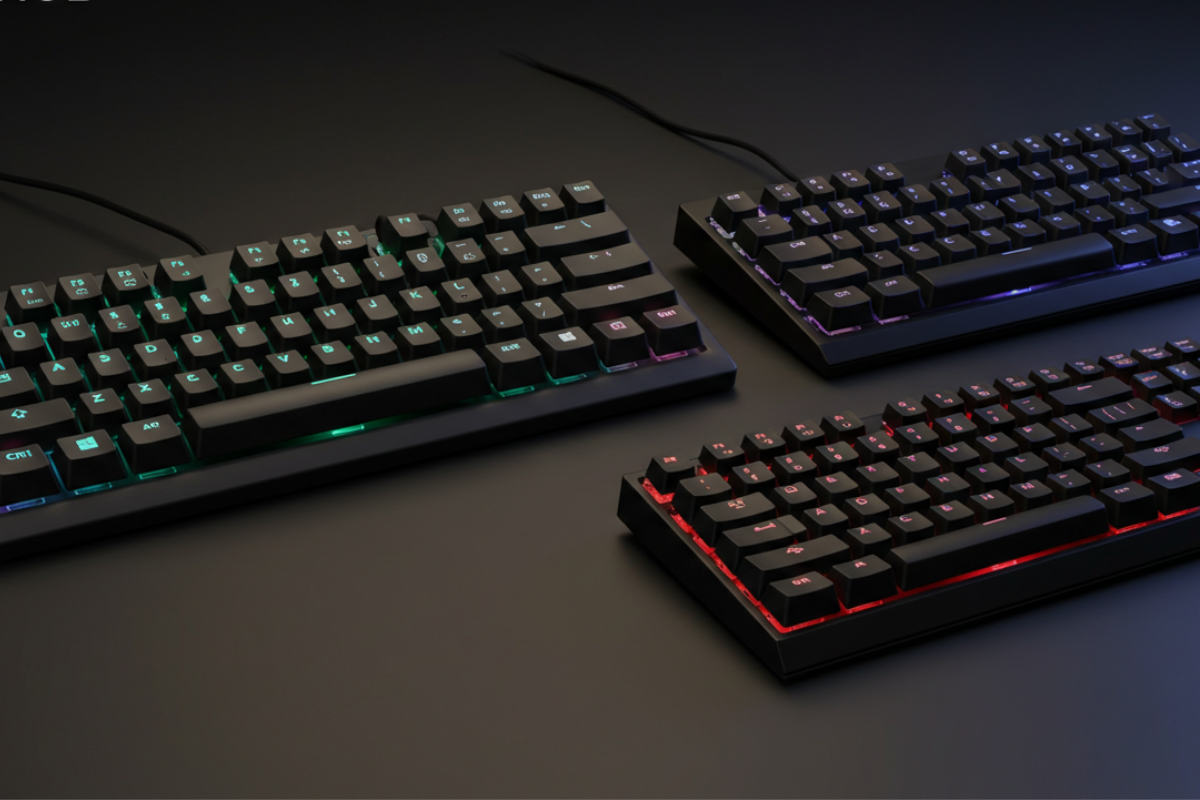RGB vs non-RGB keyboards is the topic I walk you through for Keyboards Technology. I explain what RGB means (per-key, zonal, underglow) and what non-RGB means (no light or single-color backlight). You’ll get LED facts, visibility notes, clear pros and cons, practical uses (hotkey cues, streaming), how switches, keycaps and power affect lighting and feel, plus shopping and maintenance tips so you can decide if RGB is worth it.
Key takeaway
- I prefer per-key RGB for gaming and visual cues.
- I switch RGB off on wireless boards to save battery.
- Typing quality depends on switches, not lighting.
- I pick non-RGB at work to avoid distraction and for a professional look.
- RGB adds parts and complexity that can fail; non-RGB is simpler and often more reliable.
How I define RGB vs non-RGB keyboards
What RGB lighting means: per-key, zonal, underglow
RGB = full color control and effects. I use it when I want flair or useful cues.
- Per-key: Each key can show a different color — great for game binds and macros.
- Zonal: Groups of keys share colors — clean look and lower power use.
- Underglow: LEDs under the case for desk ambience — mainly visual, less useful for typing.
| Type | What it is | Good for |
|---|---|---|
| Per-key | Individual LEDs under each key | Games, shortcuts, quick access |
| Zonal | Blocks of keys share one color | Clean looks, lower power |
| Underglow | Strip/LEDs under the board | Ambience, streaming visuals |
I test boards at Keyboards Technology. For me, per-key RGB is best for gaming; at work I usually turn it off.
What non-RGB means: no light or single-color backlight
Non-RGB = either no backlight or a single static color (often white).
- No light: Plain keys — best in bright rooms, saves battery, low distraction.
- Single-color: One LED color — useful in low light, simple and stable.
| Type | What it is | Good for |
|---|---|---|
| No light | No LEDs under keys | Battery life, low distraction, clean look |
| Single-color | One backlight color | Night use, consistent visibility |
I choose non-RGB for meetings and long battery days. Keyboards Technology offers strong non-RGB picks for office use.
Quick facts about LEDs, backlight types and visibility
- LEDs: Most keyboards use tiny surface-mount LEDs.
- Brightness: Depends on LED count and keycap material; translucent legends improve clarity.
- Color control: Full on RGB boards; none on single-color boards.
- Power draw: RGB uses more power than single-color or no backlight; hurts wireless battery life.
- Visibility: Backlight helps in low light; strong sun can wash out LEDs.
- Maintenance: Lights are extra components — dust can dim them over time.
My advice: pick the lighting that fits how you work and play.
Why I might pick RGB: RGB keyboard benefits and pros
I choose RGB when the keyboard should be more than a tool — when it adds color, feedback, and personality. Useful for gaming, streaming, and workflows with many shortcuts. Keyboards Technology models tend to have clean lighting and solid build.
Aesthetic customization and profiles
With per-key RGB you can create patterns or match themes. Profiles let you switch from a blue work theme to a red gaming theme in a click.
| Lighting type | Best for | Quick note |
|---|---|---|
| Per-key RGB | Precise effects, hotkeys | Great for gamers & streamers |
| Zone lighting | Clean looks | Easier on software and battery |
| Static backlight | Office, focus | Most battery friendly |
Practical uses: hotkeys and streaming cues
RGB is a tool, not just decoration:
- Hotkeys: color-code shortcuts for speed.
- Streaming: green = go live, red = mute.
- Cooldowns: flash keys when abilities are ready.
Small visual cues reduce mistakes and improve workflow.
Pros and cons — price, software and complexity
| Pros | Cons | My take |
|---|---|---|
| Custom lighting and cues | Higher price | Worth it for visuals/streaming |
| Profiles for apps/games | Software required | Good vendor software lowers friction |
| Immersion for games | Battery impact on wireless | Wired users avoid drain |
| Brand appeal | Learning curve | Start simple; add effects over time |
RGB adds cost and complexity, but presets often make it easy to get started.
Why I might choose non-RGB: non-RGB keyboard advantages
Non-RGB keyboards are about simplicity, reliability, and value.
Simpler setup, lower cost, more reliable drivers
Non-RGB is usually plug-and-play — no extra software, fewer background apps, more stable drivers across platforms. Non-RGB models also tend to be cheaper, letting you invest in better switches or a sturdier frame.
| Feature | RGB keyboards | Non-RGB keyboards |
|---|---|---|
| Setup | Software often required | Plug-and-play |
| Cost | Higher entry price | Lower cost |
| Drivers | More updates, potential bloat | More reliable |
Better battery life and a professional look
- With lights off, non-RGB wireless boards use far less power.
- Non-RGB keyboards look clean and professional in meetings and on video calls.
| Concern | RGB (wireless) | Non-RGB (wireless) |
|---|---|---|
| Battery drain | Higher | Lower |
| Desk appearance | Eye-catching | Professional & subtle |

Who I recommend each to: Gaming — RGB vs non-RGB keyboards
Competitive gamers: latency and polling
For competitive play, feel and speed come first. Most quality gaming keyboards offer 1000 Hz polling whether RGB or not. RGB alone usually doesn’t add delay on good hardware; cheap controllers can.
What I look for:
- Wired connection and mechanical switches.
- 1000 Hz polling set in software.
- Well-supported firmware.
| Factor | RGB models | Non-RGB models |
|---|---|---|
| Latency risk | Low on quality boards | Lowest risk overall |
| Polling rate | Usually 1000 Hz | Usually 1000 Hz |
| Useful for play? | Visual cues (cooldowns, keybinds) | Cleaner, no distractions |
| My pick | High‑end RGB with pro firmware | If budget: non‑RGB for pure speed |
I use a wired board for tournaments with lights off—reliability first.
Streamers and creators
For streaming, RGB is like stage lighting — it reinforces brand and mood. Per-key lighting and synced effects can match overlays and scenes. Stable software that switches profiles with OBS is essential.
Creator checklist:
- Per-key RGB for logo/alert zones.
- Software that saves cloud profiles and syncs with apps.
- Keep a wired backup for long sessions.
Office users and typists
For long writing or office work, non-RGB is my go-to: fewer distractions, better battery, and a formal look.
Why non-RGB:
- Focus: no shifting lights.
- Battery life: wireless models last longer.
- Professional look: blends with office gear.
| Concern | Non-RGB | RGB |
|---|---|---|
| Distraction | Low — best for focus | Higher unless off |
| Battery life (wireless) | Longer | Shorter by hours |
| Formal look | Yes | Can be flashy |
| Typist priority | Switch feel & build | Lights are icing, not the cake |
Performance, switches and power: mechanical RGB vs non-RGB comparison
How switch type and keycap transparency affect lighting and feel
- Linear switches: smooth; clear housings spread light evenly.
- Tactile switches: bump; light can be focused at the stem.
- Clicky switches: loud; clear housings make RGB look brighter.
Keycap materials:
- PBT opaque: keeps light inside, reduces glare.
- Shine-through / translucent legends: let light show through for bright legends.
| Item | Feel | Lighting |
|---|---|---|
| Linear clear housing | Smooth | Bright, even |
| Tactile clear housing | Bumpy | Good per-key |
| Clicky clear housing | Loud | Very bright |
| PBT opaque caps | Solid, muted | Low light bleed |
| Shine-through caps | Clear legends | High legend brightness |
I once used clear-housing tactiles with shine-through caps—RGB looked amazing but sound was more pronounced, better for gaming than late-night writing.
Energy consumption and wireless impact
RGB adds power draw depending on brightness and effects:
- Static low-brightness: less power.
- Full per-key animations: much more power.
- Reactive effects: extra cost.
| Mode | Power draw | Wireless battery life |
|---|---|---|
| No backlight (non-RGB) | Low | Longest |
| RGB low / steady | Medium | Good |
| RGB full per-key animations | High | Shortest |
Battery tips:
- Lower brightness to 20–40%.
- Use zones instead of per-key.
- Turn off lighting when idle or set a sleep timer.
If you need long wireless runtime, choose non-RGB or limited RGB; for desktop wired users, RGB power is rarely an issue.
Does RGB lighting impact productivity?
Yes, it can—but depends on use:
- Flashy effects distract.
- Subtle single-color light can reduce eye strain.
- Color cues (red = recording) can help workflows.
My experience: reactive rainbow effects reduced my writing productivity. Switching to soft white or off improved focus.
Workplace tips:
- Use solid color or off for focused work.
- Set low brightness.
- Reserve animations for breaks or gaming sessions.
How I shop: price, maintenance and the best non-RGB keyboard for typing
Price ranges: RGB vs non-RGB across tiers
I compare RGB vs non-RGB keyboards by typical price tiers. Price often indicates switches, keycaps, and software quality.
| Tier | Non‑RGB (USD) | RGB (USD) | What you get |
|---|---|---|---|
| Low | $20–$60 | $35–$80 | Basic case, membrane/entry switches; simple RGB on some |
| Mid | $60–$150 | $90–$250 | Better frames, hot-swap, PBT caps, per-zone RGB on many |
| High | $150–$350 | $200–$500 | Metal frames, custom switches, per-key RGB, advanced software |
Key shopping takeaways:
- For best typing feel per dollar, non-RGB mid-tier often wins.
- Budget extra for RGB if lighting and streaming matter.
- For work or long battery life, non-RGB usually gives more value.
Maintenance tips
Keep keyboards working with simple habits:
Cleaning keycaps:
- Remove caps with a puller; soak in warm soapy water.
- Dry fully (24 hours) before reassembly.
- Use a soft brush and compressed air for switch areas.
- For sticky keys, clean around stems with 90% isopropyl; avoid pouring liquid into the board.
Firmware updates:
- Check vendor updates quarterly.
- Read changelogs before updating.
- Update via USB with a stable cable; if risky, wait a minor release.
Profile backups:
- Export lighting and macro profiles before major updates.
- Name files clearly (ex: KT-TKL-profile_2025-08-01.json).
- Store backups in cloud and local folders; test restores.
Quick maintenance schedule:
| Task | Frequency | Tip |
|---|---|---|
| Remove & wash keycaps | Every 3–6 months | Photo-record layout first |
| Compressed air / brush | Monthly | Hold board angled to avoid pushing debris in |
| Firmware check | Quarterly | Read changelog; back up profiles |
| Profile backups | Before updates | Save cloud local copy |
Quick buying checklist — Are RGB keyboards worth it for me?
- Stream / want flashy visuals? — lean RGB.
- Work in office / need long wireless battery? — pick non-RGB.
- Care most about typing feel/sound? — non-RGB often wins.
- On a tight budget? — non-RGB gives more typing quality per dollar.
- Want per-key macros and visual cues? — RGB helps.
- Won’t manage firmware/profiles? — avoid complex RGB ecosystems.
My rule: if lighting is a tool or brand statement, pay for RGB; if focus, runtime, or pure feel matters, choose non-RGB.

Conclusion
I keep it simple: RGB vs non-RGB keyboards boils down to purpose. RGB is the icing — it adds personality, immersion, and useful visual cues for streamers and gamers. Trade-offs: higher cost, extra software, and shorter battery life on wireless boards. For pure work, long typing sessions, or travel, non-RGB is the smarter, simpler choice: plug-and-play, quieter on resources, better battery life, and a clean professional look.
My practical rules at Keyboards Technology: start simple, tune brightness, use zones when possible, and back up profiles before updates. Those habits keep the lights from stealing the show.
Frequently asked questions
RGB vs non-RGB keyboards: Which is better for gaming?
I recommend RGB for games if you want visual cues and immersion. For pure competitive play, choose a quality wired keyboard (RGB or not) with low latency and 1000 Hz polling.
Are RGB vs non-RGB keyboards worth the extra cost?
It depends on your priorities. Pay extra for RGB if you value looks, cues, and streaming. For typing feel per dollar, non-RGB often gives more value.
Do RGB lights drain battery on wireless keyboards?
Yes. Full per-key RGB and animations shorten battery life noticeably. Use low brightness, zones, or turn lights off to save power.
Can I turn RGB off if it distracts me?
Absolutely. Most keyboards offer shortcuts or software to switch lighting off and save quiet profiles on-board.
Which is better for office work: RGB vs non-RGB keyboards?
I prefer non-RGB for focus and formality. If you need backlight in low light, a subtle single-color option is a good compromise.

